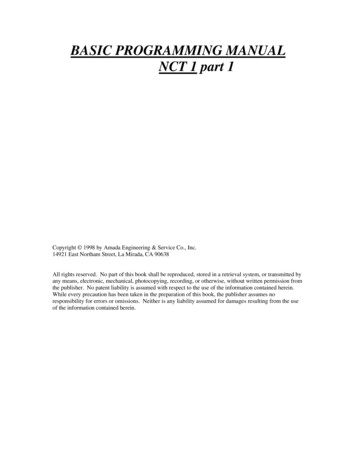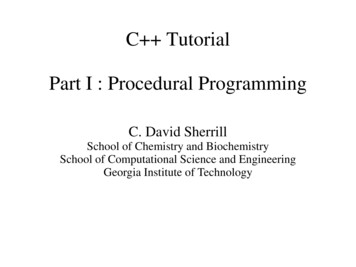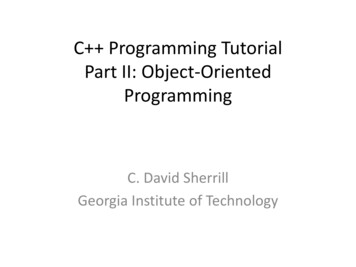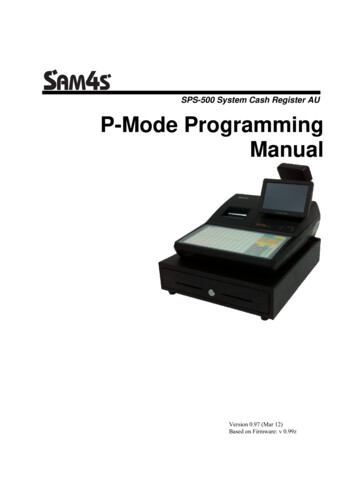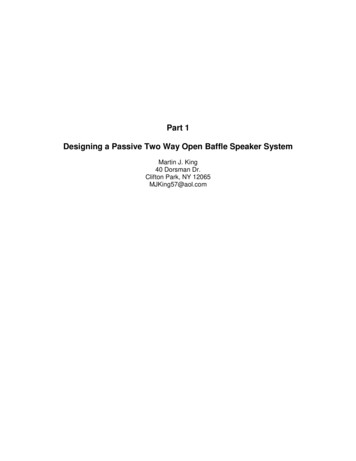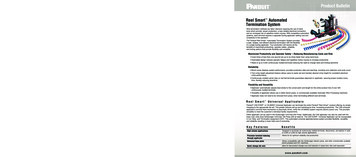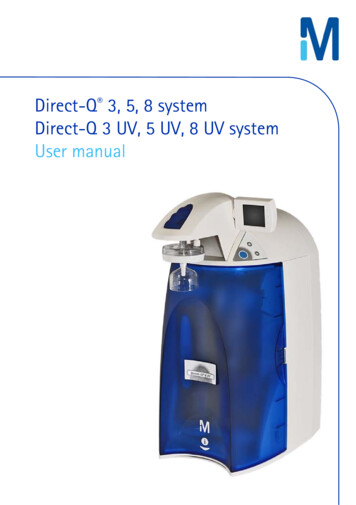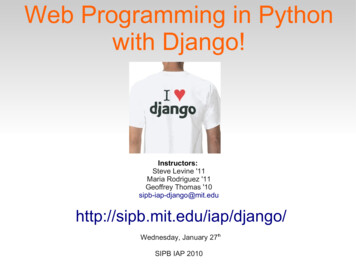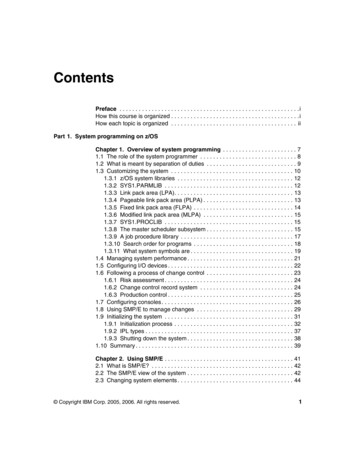
Transcription
ContentsPreface . . . . . . . . . . . . . . . . . . . . . . . . . . . . . . . . . . . . . . . . . . . . . . . . . . . . . . . .iHow this course is organized . . . . . . . . . . . . . . . . . . . . . . . . . . . . . . . . . . . . . . . .iHow each topic is organized . . . . . . . . . . . . . . . . . . . . . . . . . . . . . . . . . . . . . . . iiPart 1. System programming on z/OSChapter 1. Overview of system programming . . . . . . . . . . . . . . . . . . . . . . . 71.1 The role of the system programmer . . . . . . . . . . . . . . . . . . . . . . . . . . . . . . 81.2 What is meant by separation of duties . . . . . . . . . . . . . . . . . . . . . . . . . . . . 91.3 Customizing the system . . . . . . . . . . . . . . . . . . . . . . . . . . . . . . . . . . . . . . 101.3.1 z/OS system libraries . . . . . . . . . . . . . . . . . . . . . . . . . . . . . . . . . . . . 121.3.2 SYS1.PARMLIB . . . . . . . . . . . . . . . . . . . . . . . . . . . . . . . . . . . . . . . . 121.3.3 Link pack area (LPA). . . . . . . . . . . . . . . . . . . . . . . . . . . . . . . . . . . . . 131.3.4 Pageable link pack area (PLPA) . . . . . . . . . . . . . . . . . . . . . . . . . . . . 131.3.5 Fixed link pack area (FLPA) . . . . . . . . . . . . . . . . . . . . . . . . . . . . . . . 141.3.6 Modified link pack area (MLPA) . . . . . . . . . . . . . . . . . . . . . . . . . . . . 151.3.7 SYS1.PROCLIB . . . . . . . . . . . . . . . . . . . . . . . . . . . . . . . . . . . . . . . . 151.3.8 The master scheduler subsystem . . . . . . . . . . . . . . . . . . . . . . . . . . . 151.3.9 A job procedure library . . . . . . . . . . . . . . . . . . . . . . . . . . . . . . . . . . . 171.3.10 Search order for programs . . . . . . . . . . . . . . . . . . . . . . . . . . . . . . . 181.3.11 What system symbols are . . . . . . . . . . . . . . . . . . . . . . . . . . . . . . . . 191.4 Managing system performance . . . . . . . . . . . . . . . . . . . . . . . . . . . . . . . . . 211.5 Configuring I/O devices . . . . . . . . . . . . . . . . . . . . . . . . . . . . . . . . . . . . . . . 221.6 Following a process of change control . . . . . . . . . . . . . . . . . . . . . . . . . . . 231.6.1 Risk assessment . . . . . . . . . . . . . . . . . . . . . . . . . . . . . . . . . . . . . . . . 241.6.2 Change control record system . . . . . . . . . . . . . . . . . . . . . . . . . . . . . 241.6.3 Production control . . . . . . . . . . . . . . . . . . . . . . . . . . . . . . . . . . . . . . . 251.7 Configuring consoles. . . . . . . . . . . . . . . . . . . . . . . . . . . . . . . . . . . . . . . . . 261.8 Using SMP/E to manage changes . . . . . . . . . . . . . . . . . . . . . . . . . . . . . . 291.9 Initializing the system . . . . . . . . . . . . . . . . . . . . . . . . . . . . . . . . . . . . . . . . 311.9.1 Initialization process . . . . . . . . . . . . . . . . . . . . . . . . . . . . . . . . . . . . . 321.9.2 IPL types . . . . . . . . . . . . . . . . . . . . . . . . . . . . . . . . . . . . . . . . . . . . . . 371.9.3 Shutting down the system . . . . . . . . . . . . . . . . . . . . . . . . . . . . . . . . . 381.10 Summary . . . . . . . . . . . . . . . . . . . . . . . . . . . . . . . . . . . . . . . . . . . . . . . . . 39Chapter 2. Using SMP/E . . . . . . . . . . . . . . . . . . . . . . . . . . . . . . . . . . . . . . . . 412.1 What is SMP/E? . . . . . . . . . . . . . . . . . . . . . . . . . . . . . . . . . . . . . . . . . . . . 422.2 The SMP/E view of the system . . . . . . . . . . . . . . . . . . . . . . . . . . . . . . . . . 422.3 Changing system elements . . . . . . . . . . . . . . . . . . . . . . . . . . . . . . . . . . . . 44 Copyright IBM Corp. 2005, 2006. All rights reserved.1
2.42.52.62.7Introducing an element into the system. . . . . . . . . . . . . . . . . . . . . . . . . . . 44Preventing problems with an element . . . . . . . . . . . . . . . . . . . . . . . . . . . . 46Fixing problems with an element. . . . . . . . . . . . . . . . . . . . . . . . . . . . . . . . 47Customizing an element - USERMOD SYSMOD . . . . . . . . . . . . . . . . . . . 482.7.1 Prerequisites and corequisites . . . . . . . . . . . . . . . . . . . . . . . . . . . . . 492.8 Tracking and controlling elements. . . . . . . . . . . . . . . . . . . . . . . . . . . . . . . 502.9 Working with SMP/E . . . . . . . . . . . . . . . . . . . . . . . . . . . . . . . . . . . . . . . . . 502.9.1 SMP/E basic commands . . . . . . . . . . . . . . . . . . . . . . . . . . . . . . . . . . 512.10 When is SMP/E used? . . . . . . . . . . . . . . . . . . . . . . . . . . . . . . . . . . . . . . 622.11 Why is SMP/E used?. . . . . . . . . . . . . . . . . . . . . . . . . . . . . . . . . . . . . . . . 632.12 Terminology. . . . . . . . . . . . . . . . . . . . . . . . . . . . . . . . . . . . . . . . . . . . . . . 632.12.1 Communicating with IBM Defect Support . . . . . . . . . . . . . . . . . . . . 632.12.2 Consolidate Software Inventory (CSI) and zones . . . . . . . . . . . . . . 642.12.3 Maintenance . . . . . . . . . . . . . . . . . . . . . . . . . . . . . . . . . . . . . . . . . . 652.13 Local SMP/E Environments. . . . . . . . . . . . . . . . . . . . . . . . . . . . . . . . . . . 672.13.1 Production, Test and Emergency Fix . . . . . . . . . . . . . . . . . . . . . . . 672.13.2 Base z/OS and Product CSIs . . . . . . . . . . . . . . . . . . . . . . . . . . . . . 682.14 How to use SMP/E . . . . . . . . . . . . . . . . . . . . . . . . . . . . . . . . . . . . . . . . . 682.14.1 SYSMOD. . . . . . . . . . . . . . . . . . . . . . . . . . . . . . . . . . . . . . . . . . . . . 682.14.2 JCL . . . . . . . . . . . . . . . . . . . . . . . . . . . . . . . . . . . . . . . . . . . . . . . . . 692.14.3 RECEIVE Command . . . . . . . . . . . . . . . . . . . . . . . . . . . . . . . . . . . . 692.14.4 APPLY Command . . . . . . . . . . . . . . . . . . . . . . . . . . . . . . . . . . . . . . 692.14.5 ACCEPT Command . . . . . . . . . . . . . . . . . . . . . . . . . . . . . . . . . . . . 702.14.6 LIST Command . . . . . . . . . . . . . . . . . . . . . . . . . . . . . . . . . . . . . . . . 702.15 ISPF . . . . . . . . . . . . . . . . . . . . . . . . . . . . . . . . . . . . . . . . . . . . . . . . . . . . 702.16 Order and download IBM fixes . . . . . . . . . . . . . . . . . . . . . . . . . . . . . . . . 742.17 Summary . . . . . . . . . . . . . . . . . . . . . . . . . . . . . . . . . . . . . . . . . . . . . . . . . 74Chapter 3. Hardware systems and LPARs . . . . . . . . . . . . . . . . . . . . . . . . . 773.1 Overview of mainframe hardware systems . . . . . . . . . . . . . . . . . . . . . . . . 783.2 Early system design . . . . . . . . . . . . . . . . . . . . . . . . . . . . . . . . . . . . . . . . . 793.3 Current design. . . . . . . . . . . . . . . . . . . . . . . . . . . . . . . . . . . . . . . . . . . . . . 813.3.1 I/O connectivity . . . . . . . . . . . . . . . . . . . . . . . . . . . . . . . . . . . . . . . . . 823.3.2 System control and partitioning . . . . . . . . . . . . . . . . . . . . . . . . . . . . . 843.3.3 Characteristics of LPARs . . . . . . . . . . . . . . . . . . . . . . . . . . . . . . . . . 863.3.4 Consolidation of mainframes. . . . . . . . . . . . . . . . . . . . . . . . . . . . . . . 873.4 Processing units . . . . . . . . . . . . . . . . . . . . . . . . . . . . . . . . . . . . . . . . . . . . 883.5 Multiprocessors . . . . . . . . . . . . . . . . . . . . . . . . . . . . . . . . . . . . . . . . . . . . . 893.6 Disk devices . . . . . . . . . . . . . . . . . . . . . . . . . . . . . . . . . . . . . . . . . . . . . . . 903.7 Clustering . . . . . . . . . . . . . . . . . . . . . . . . . . . . . . . . . . . . . . . . . . . . . . . . . 923.7.1 Basic shared DASD . . . . . . . . . . . . . . . . . . . . . . . . . . . . . . . . . . . . . 923.7.2 CTC rings . . . . . . . . . . . . . . . . . . . . . . . . . . . . . . . . . . . . . . . . . . . . . 943.7.3 Parallel sysplex . . . . . . . . . . . . . . . . . . . . . . . . . . . . . . . . . . . . . . . . . 952z/OS Basics
3.8 Typical mainframe systems. . . . . . . . . . . . . . . . . . . . . . . . . . . . . . . . . . . . 973.8.1 Very small systems . . . . . . . . . . . . . . . . . . . . . . . . . . . . . . . . . . . . . . 973.8.2 Medium single systems. . . . . . . . . . . . . . . . . . . . . . . . . . . . . . . . . . . 983.8.3 Larger systems . . . . . . . . . . . . . . . . . . . . . . . . . . . . . . . . . . . . . . . . . 993.9 Summary . . . . . . . . . . . . . . . . . . . . . . . . . . . . . . . . . . . . . . . . . . . . . . . . . 101Chapter 4. Parallel Sysplex and continuous availability. . . . . . . . . . . . . 1034.1 Future of the new mainframe . . . . . . . . . . . . . . . . . . . . . . . . . . . . . . . . . 1044.2 What a Parallel Sysplex is. . . . . . . . . . . . . . . . . . . . . . . . . . . . . . . . . . . . 1044.2.1 Shared data clustering . . . . . . . . . . . . . . . . . . . . . . . . . . . . . . . . . . 1054.2.2 Non-disruptive maintenance . . . . . . . . . . . . . . . . . . . . . . . . . . . . . . 1064.3 Continuous availability of mainframes. . . . . . . . . . . . . . . . . . . . . . . . . . . 1064.3.1 No single points of failure . . . . . . . . . . . . . . . . . . . . . . . . . . . . . . . . 1074.3.2 Capacity and scaling . . . . . . . . . . . . . . . . . . . . . . . . . . . . . . . . . . . . 1084.3.3 Dynamic workload balancing . . . . . . . . . . . . . . . . . . . . . . . . . . . . . 1084.3.4 Ease of use . . . . . . . . . . . . . . . . . . . . . . . . . . . . . . . . . . . . . . . . . . . 1094.3.5 Single system image . . . . . . . . . . . . . . . . . . . . . . . . . . . . . . . . . . . . 1114.3.6 Compatible change and non-disruptive growth . . . . . . . . . . . . . . . . 1124.3.7 Application compatibility . . . . . . . . . . . . . . . . . . . . . . . . . . . . . . . . . 1124.3.8 Disaster recovery . . . . . . . . . . . . . . . . . . . . . . . . . . . . . . . . . . . . . . 1134.4 Summary . . . . . . . . . . . . . . . . . . . . . . . . . . . . . . . . . . . . . . . . . . . . . . . . . 113Contents3
4z/OS Basics
PrefaceThis course provides students of information systems technology with the backgroundknowledge and skills necessary to begin using the basic facilities of a mainframecomputer.For optimal learning, students are assumed to have successfully completed anintroductory course in computer system concepts, such as computer organization andarchitecture, operating systems, data management, or data communications. They shouldalso have successfully completed courses in one or more programming languages, and bePC literate.Note that this course can also be used as a prerequisite for courses in advanced topicssuch as compiler algorithms, or for internships and special studies.Others who will benefit from this course include data processing professionals who haveexperience with non-mainframe platforms, or who are familiar with some aspects of themainframe but want to become knowledgeable with other facilities and benefits of themainframe environment.When moving through this course, instructors are encouraged to alternate betweencourse, lecture, discussions, and hands-on exercises. The instructor-led discussions andhands-on exercises are an integral part of the learning experience, and can include topicsnot covered in this course.After completing this course, students will have received: A general introduction to mainframe concepts, usage, and architecture A comprehensive overview of z/OS, a widely used mainframe operating system An understanding of mainframe workloads and an overview of the major middlewareapplications in use on mainframes today The basis for subsequent course work in more advanced, specialized areas of z/OS,such as system administration or application programmingHow this course is organizedThis course is organized in four parts, as follows: Part 1. “Introduction to z/OS and the mainframe environment” provides anoverview of the types of workloads commonly processed on the mainframe, such asbatch jobs and online transactions. This part of the course helps students explore the Copyright IBM Corp. 2005, 2006. All rights reserved.i
user interfaces of z/OS, a widely used mainframe operating system. Discussion topicsinclude TSO/E and ISPF, UNIX interfaces, job control language, file structures, andjob entry subsystems. Special attention is paid to the users of mainframes and to theevolving role of mainframes in today’s business world. Part 2. “Application programming on z/OS” introduces the tools and utilities fordeveloping a simple program to run on z/OS. This part of the course guides thestudent through the process of application design, choosing a programming language,and using a runtime environment. Part 3. “Online workloads for z/OS” examines the major categories of interactiveworkloads processed by z/OS, such as transaction processing, database management,and Web-serving. This part of the course includes discussions of several popularmiddleware products, including DB2 , CICS , and WebSphere ApplicationServer. Part 4. “System programming on z/OS” provides topics to help the student becomefamiliar with the role of the z/OS system programmer. This part of the courseincludes discussions of system libraries, starting and stopping the system, security,network communications and the clustering of multiple systems. Also provided is anoverview of mainframe hardware systems, including processors and I/O devices.In this course, we use simplified examples and focus mainly on basic system functions.Hands-on exercises are provided throughout the course to help students explore themainframe style of computing. Exercises include entering work into the system, checkingits status, and examining the output of submitted jobs.How each topic is organizedEach topic follows a common format: Objectives for the student Topics that teach a central theme related to mainframe computing Summary of the main ideas of the topic A list of key terms introduced in the topic Questions for review to help students verify their understanding of the material Topics for further discussion to encourage students to explore issues that extendbeyond the topic objectives Hands-on exercises intended to help students reinforce their understanding of thematerialiiz/OS Basics
Prefaceiii
ivz/OS Basics
Part1System programming onz/OSIn this part we reveal the inner workings of z/OS with discussions of system libraries,change management, and procedures for starting (IPLing) and stopping a z/OS system.This part also includes chapters on hardware details and virtualization, and the clusteringof multiple z/OS systems in a sysplex. Copyright IBM Corp. 2005, 2006. All rights reserved.5
6z/OS Basics
1Chapter 1.Overview of systemprogrammingObjective: As a z/OS system programmer, you need to know how to start the systemand how to bring it down again. You must also understand the role of z/OS systemlibraries, such as PARMLIB and linklist, and how these libraries affect the processingof z/OS. Also important is a familiarity with SMP/E, the z/OS utility that helps youcoordinate changes to the system software.After completing this topic, you will be able to: List the major responsibilities of a z/OS system programmer Discuss the system libraries, their use, and methods for managing their content Explain how proper installation and maintenance are the basis for high availabilityin the z/OS environment. Describe the process of IPLing a system. Copyright IBM Corp. 2005, 2006. All rights reserved.7
1.1 The role of the system programmerThe system programmer is responsible for managing the mainframe hardwareconfiguration, and installing, customizing, and maintaining the mainframe operatingsystem. Installations need to ensure that their system and its services are available andoperating to meet service level agreements. Installations with 24-hour, 7-day operationsneed to plan for minimal disruption of their operation activities.In this topic, we examine several areas of interest for the would-be z/OS systemprogrammer. While this course cannot cover every aspect of system programming, it’simportant to learn that the job of the z/OS system programmer is very complex andrequires skills in many aspects of the system, such as: Device I/O configurationsProcessor configurationsConsole definitionsSystem libraries where the software is placedSystem data sets and their placementCustomization parameters that are used to define your z/OS configurationInstallation and maintenance using SMP/E.Security administrationAs shown in Figure 1-1 on page 9, the role of system programmer usually includes somedegree of involvement in all of the following aspects of system operation: “Customizing the system” on page 10“Managing system performance” on page 21“Configuring I/O devices” on page 22“Following a process of change control” on page 23“Configuring consoles” on page 26“Initializing the system” on page 31We discuss mainframe hardware configurations in Chapter 3, “Hardware systems andLPARs” on page 77.8z/OS Basics
SYSTEM PROGRAMMINGSecurity, Availabilityand IntegritySystem performanceand workloadmanagementSystemparametersand systemlibrariesmanagementControlling operatingactivities and functionsiodfxxz/OS new featuresimplementation and z/OS systemmaintenanceHardware I/OconfigurationFigure 1-1 Some areas in which the system programmer is involved1.2 What is meant by separation of dutiesIn a large z/OS installation, there is usually a “separation of duties” both among membersof the system programming staff, and between the system programming department andother departments in the IT organization.A typical z/OS installation includes the following roles and more: z/OS system programmerCICS system programmerDatabase system programmerDatabase administratorChapter 1. Overview of system programming9
Network system programmerAutomation specialistSecurity managerHardware managementProduction control analystSystem operatorNetwork operatorSecurity administratorService managerIn part, the separation is an audit requirement—ensuring that one person does not havetoo much power on a system.When a new application is to be added to a system, for example, a number of tasks needto be performed before the application can be used by end users. A production controlanalyst is needed to add batch applications into the batch scheduling package, add thenew procedures to a procedure library, and set up the operational procedures. The systemprogrammer is needed to perform tasks concerned with the system itself, such as settingup security privileges and adding programs to system libraries. The programmer is alsoinvolved with setting up any automation for the new application.On a test system, however, a single person might have to perform all the roles, includingbeing the operator, and this is often the best way to learn how everything works.1.3 Customizing the systemThis section describes the following topics: System libraries where the software is locatedSystem data sets and their placementI/O device configurationConsole definitionsCustomization parameters used to define the z/OS configurationz/OS implementation and maintenanceAs can be seen in Figure 1-2 on page 11, different types of data exist in a system. Firstthere is the z/OS software as supplied by IBM. This is usually installed to a series of diskvolumes known as the system residence volumes (SYSRES).Much of the flexibility of z/OS is built on these SYSRES sets. They make it possible toapply maintenance to a new set that is cloned from the production set while the currentset is running production work. A short outage can then be taken to IPL from the newset—and the maintenance has been implemented! Also, the change can be backed out byIPLing from the old set.10z/OS Basics
Fixes to z/OS are managed with a product called System Management Program/Extended(SMP/E). Indirect cataloging using system symbols is used so that a particular library iscatal
8 z/OS Basics 1.1 The role of the system programmer The system programmer is responsible for managing the mainframe hardware configuration, and installing, customizing, and maintaining the mainframe operating system. Installations need to ensure that their system and its services are

